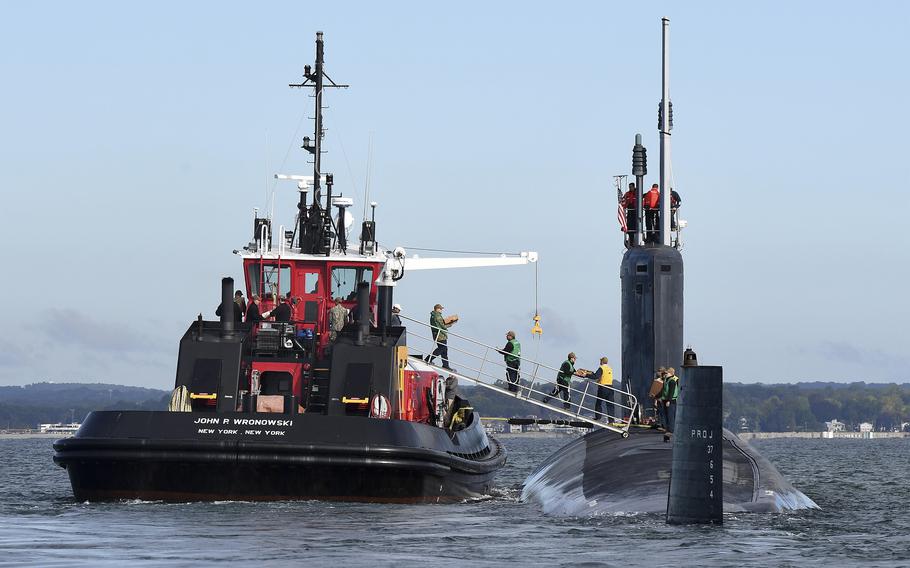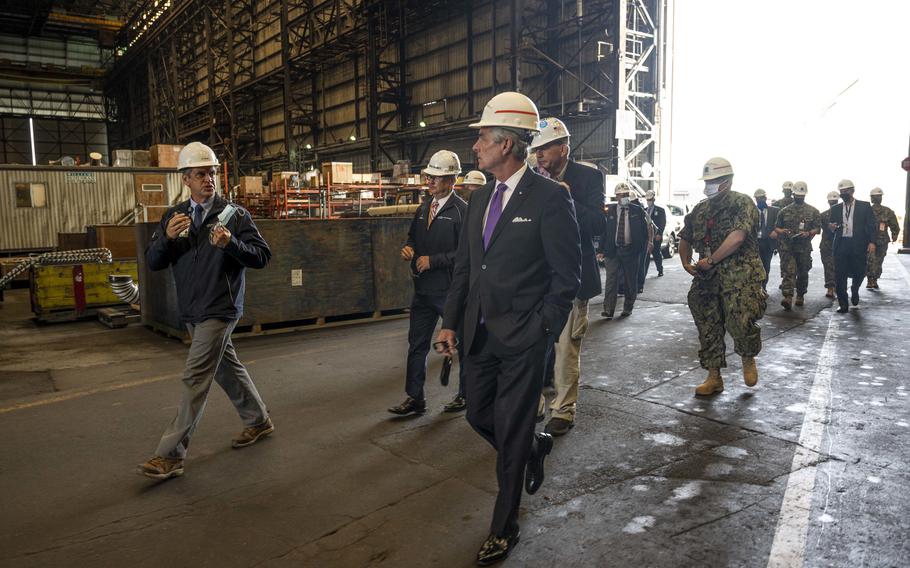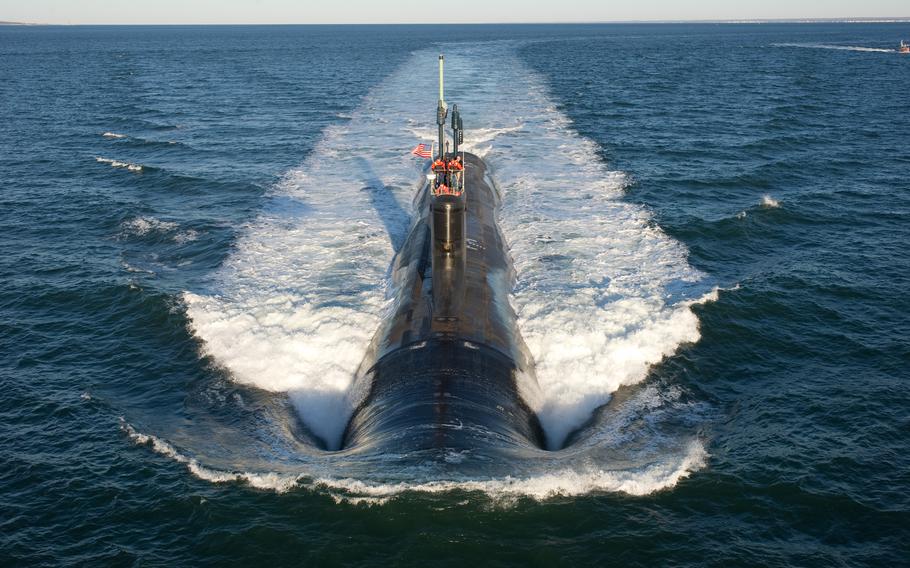
The U.S. Navy Virginia-class fast-attack submarine USS Oregon is resupplied from the tug boat John P. Wronowski during maneuvers on the Thames River near Naval Submarine Base New London, Oct. 6, 2022, in Groton, Connecticut. (Wesley Towner/U.S. Navy)
GROTON, Connecticut (Tribune News Service) — Electric Boat hired 3,700 shipbuilders last year. It wants to hire more than 5,000 this year and just as many every year for decades into the future.
Last spring, it hired a fifth of the University of Connecticut ’s engineering grads. At the other end of the education pipeline, it is promoting shipbuilding careers in elementary schools, setting its sights on second graders who will join the workforce when EB hopes to hit its peak employment target in 10 years.
“My first words to you this morning,” President Kevin Graney deadpanned last week to a roomful of political, government and military officials at a breakfast meeting at the Mystic Marriott. “EB is hiring.”
The nation’s foremost builder of submarines is, Graney said, in the midst of a “once in generation expansion,” producing for its principal customer, the U.S. Navy, the ships that will form the front line in a scramble by the U.S. and its allies to catch up with and contain Chinese expansionism.
But one of the challenges emerging from a new shipbuilding boom is a shortage of shipbuilders.
The country is spending more than $13 billion a year on the two new, lethal and virtually undetectable classes of nuclear-powered submarines Electric Boat is building for the Navy, Virginia class attack submarines and the Columbia class ballistic missile submarines.
As construction gears up, there is concern over whether Electric Boat — and the thousands of other manufacturers in the supply chain known as the submarine industrial base — can hire and begin production quickly enough to meet the aggressive construction and delivery schedule on which the Navy says U.S. security depends.
An Australian Connection?
Decades of relatively flat, post-cold war spending that shrunk the U.S. Naval fleet by half has also depleted the ranks of welders, shipfitters and riggers who build ships, as well as the companies that supply them. America hasn’t built submarines since 1995 when, with the collapse of the Soviet Union and China not yet a concern, Congress killed the 29-boat Seawolf class after EB built only three boats.
Lay-offs, retirements, industrial outsourcing and the trend toward college also contributed to labor and supply chain shrinkage. Between the 1980s, when EB was booming with work on dozens of Los Angeles and Trident class submarines, and today, the Navy says the manufacturing segment of the U.S. workforce slipped from 35 to 12 percent.
By scouring the northeast for tradesmen and engineers, Electric Boat says it is meeting and will continue to meet the Navy’s ambitious delivery schedule of two Virginia and one Columbia class submarines a year.
But the labor pool and supply chain could get another test later this month. After more than a year of talks, Australia, the United Kingdom and the U.S. are expected to roll out details of their September 2021 agreement known as AUKUS, a trilateral security pact in which the Americans and British are committed to helping Australia build a modern, nuclear-powered submarine fleet as another component of the allied effort to contain China.
Australia wants eight, state-of-the-art, nuclear-powered submarines to replace its obsolete fleet of Collins class diesel boats. It has a number of options to do so under AUKUS, while starting the daunting work of opening shipyards and Navy bases and creating its own supply chain and submarine industrial base. One of the more likely options involves buying Virginia class submarines, known as SSNs, from the U.S. EB would make billions on the sales, but experience greater pressure on its construction capacity.
Late last year, two influential members of the Senate Armed Services Committee — Rhode Island Democrat Jack Reed and then soon to retire Oklahoma Republican Daniel Inhofe — warned President Joseph Biden against giving submarines to the Australians. In a private letter that was later leaked, the two wrote that given its limited industrial capacity, the U.S. cannot build enough submarines to both defend itself and arm allies.
“We are concerned that what was initially touted as a ‘do no harm’ opportunity to support Australia and the United Kingdom and build long-term competitive advantages for the U.S. and its Pacific allies, may be turning into a zero-sum game for scarce, highly advanced U.S. SSNs,” they said.

Then-Secretary of the Navy Kenneth J. Braithwaite, right, tours General Dynamics Electric Boat in Groton, Conn on July 8, 2020. Braithwaite visited five shipyard locations to view current work, tour facilities, and meet with shipbuilders to discuss industrial base economic wellness and workforce health, ensuring all are able to support Navy priorities for Sailors and Marines. (Alexander C. Kubitza/U.S. Navy )
U.S. Rep. Joe Courtney, a leading AUKUS supporter whose district, like Reed’s, includes an EB shipyard, pushed back with a letter co-signed by eight bipartisan colleagues on the Seapower subcommittee of the House Armed Services Committee. They argued that a transfer is needed not only to contain China but as a means of forcing an expansion of U.S. shipbuilding capacity.
“These realities should not be viewed as a reason not to pursue US build submarine options in AUKUS but rather as a unique opportunity to leverage the support and resources possible under AUKUS to grow our industrial base to support both US and Australian submarine construction, recognizing that the full fruition of AUKUS over many decades will result in Australia’s ability to domestically produce nuclear-powered submarines,” Courtney and the others wrote..
The Columbias and Virginias
The Virginia as well as the Columbia class submarines are the most sophisticated weapons platforms ever designed. Both classes have such highly evolved quieting technology that they are all but invisible to enemy sonar, allowing them to approach targets or launch points without detection. Their nuclear plants give them unlimited range and ability to remain submerged.
A senior manager on EB’s Columbia program called those submarines more technologically complex than NASA’s space shuttle. At about $9.15 billion a piece, they cost more than five times as much.
The Columbia is designed as a submerged missile platform. It is 560 feet long, displaces nearly 21,000 tons and launches Trident II missiles from 16 launch tubes. Because of its mobility and ability to conceal itself in the ocean depths, it is considered the most survivable leg of the nation’s nuclear triad of land, air and sea-based missiles.
It takes about 84 months to build a Columbia. The Navy says it needs 12, which, when complete, will carry about 70 percent of the country’s nuclear arsenal.
The Navy wants to build at least 60 of the smaller Virginia class boats, hunter-killers designed to destroy enemy submarines and surface ships, deliver missiles to land targets, deploy special operations teams, support naval battle groups and carry out intelligence gathering missions.

The Virginia-class attack submarine Pre-Commissioning Unit Mississippi (SSN 782) conducts alpha trials in the Atlantic Ocean. (U.S. Navy )
Early ships in the class were 377 feet long, but follow-on boats are being extended 84 feet to accommodate four vertical launch tubes capable of firing 28 Tomahawk missiles. They take five years to build and cost about $2.8 without missile tubes and $3.5 billion each with them.
Electric Boat designed both classes, but shares about half the Virginia work and a much smaller portion of the Columbia work with the country’s other submarine builder, Newport News Shipbuilding, a division of Huntington Ingalls Industries.
EB’s work is done at its shipyards at the mouth of the Thames River in Groton and at Quonset Point, RI. Between both locations, the company has invested $2 billion in high tech manufacturing improvements, some of which were needed to accommodate the massive new Columbias.
At Quonset Point, hundreds of tons of steel are shaped into cylindrical hull sections, packed with equipment and shipped by barge to Groton, where the sections are completed and welded together.
To assemble the Columbia, EB built a 200,000 square foot structure that sits over the Thames River on more than 500 massive concrete pilings driven into the granite riverbed. Just yards away is a new structure where the modular ship command and control centers will be tested before installation.
EB began work on the first Columbia, the District of Columbia, last year. Graney said it is 30 percent complete and on schedule for delivery to the Navy in 2027. Work on the second, the Wisconsin, starts next year.
Last week, there were four Virginia boats at the Groton yard, either already delivered to the Navy, awaiting delivery or near completion – Vermont, Iowa, Idaho and Hyman Rickover, named for the U.S. Admiral credited with developing the Navy’s nuclear powered propulsion system.
Between the two classes, the Navy expects delivery of three boats a year from EB and Newport News. As a measure of the complexity of the new submarines, Electric Boat launched 74 diesel submarines during World War II.
Electric Boat said it is meeting the delivery schedule and will continue to do so, although there was a slippage in the Virginia work after a portion of its tight workforce was shifted to the Columbia program when the Navy designated that as the nation’s top defense priority.
“The Columbia class remains our top priority,” Adm. John Richardson, the Chief of Naval Operations, has said. “It is foundational to our survival as a nation.”
The AUKUS trilateral security pact
EB is not talking about how its delivery schedule could be affected if, under AUKUS, its workload increases by a U.S. commitment to provide Australia with Virginia class submarines. Delivery schedules have become increasingly important in the rush to keep up with China, as well as developments in Russian submarine technology and armament.
“The question is, can we actually pull it off and how quickly can we pull it off,” said Charles Edel, inaugural Australia chair and a senior advisor at the Center for Strategic and International Studies. “Frankly, if Australia doesn’t get any submarines until 2040 that doesn’t do us much good. And when we think about deterring China, particularly from a Taiwan type of contingency, we need things both in the water, under the water and that fly very fast through the air.”
Australia developed the concept behind the AUKUS and pressed the U.S. and Great Britain because of concern over Chinese interference in its domestic affairs. Among other things, China — Australia’s largest trading partner — staggered the Australian economy by blocking its exports after Australia supported an international inquiry into the origins of the coronavirus. Over the last three years, Australian polling shows that trust in China plunged from from 52 to 16 percent.
The purpose of AUKUS is to bootstrap Australia’s outdated diesel submarine force into a credible barrier to the Chinese chiefly through the sharing of closely guarded American nuclear propulsion technology. The U.S. has shared that technology only once before, more than 40 years ago with Great Britain.
The plan, in the long term, is for Australia to create and support its own nuclear fleet by building shipyards, naval bases and the industrial infrastructure for both. In the interim, the U.S., England or some combination or the two would give Australia the range to patrol the western Pacific by providing it with state of the art submarines propelled with U.S. nuclear propulsion systems.
Biden signed AUKUS 18 months ago. Sometime this month, on a date yet to be chosen, he and the prime ministers of Great Britain and Australia will meet and reveal details of how the agreement will work, among them how Australia gets submarines and from whom.
“We have made the recognition that China has poured billions of dollars into military modernization and it has really shifted the balance of power in the Indo-Pacific region,” Edel said. “And there has been a decision that we have not kept pace with China nor have our allies and partners and the only way that we are going to remain ahead and create a favorable balance of power is if we can turbo charge out closest allies who are most willing and most capable themselves.”
Like everything else concerning new submarine construction, here and in the United Kingdom, questions about who gets to sell subs to Australia have been clouded by who has the capacity to build them.
For months, the Australian press has been dominated by the question. Last week’s headlines suggest a momentum shift from Britain to the U.S. Australian opposition leader and former defense minister Peter Dutton told the Australian Broadcast Corporation that the Virginia is a better boat than the British Astute class nuclear-powered submarines and, what’s more, he doubts the United Kingdom, which requires ten years to build an Astute, has the industrial capacity to build submarines for Australia.
“The beauty in my mind with the American model of the Virginia class was that it is a proven design,” Dutton said. “It gave us interoperability with the Americans and there will be more American subs in the Indo-Pacific than British submarines.”
Electric Boat recruitment
Anyone in northern New England playing close attention to a televised Red Sox game over the summer, or a Patriots game last fall, probably got a recruitment pitch from Electric Boat. And the company is not only looking far afield for shipyard workers, but far into the future.
“We have a program called ‘The boat for kids,” said Courtney Murphy, the company’s director of talent acquisition, workforce development and compensation. “ We go into elementary schools with age appropriate activities that help them understand what kind of work we do.
“So we have second graders welding with Cheez Whiz and crackers. We are really trying to capture their interest and help them understand that we are here and build our branding early.”
Graney said the shipyard will spend more than $1 billion over the next five years to support the vendors, machine shops, laboratories and others that make up the submarine industrial base supply network in Connecticut. The Navy is spending close to $1 billion more on industrial base here and elsewhere.
There are recruitment efforts in high schools, trade schools and community colleges across the state with free training for anyone who wants to work.
State government is exploring ways to create housing in the tight southeastern part of the state for shipbuilders hired from out of state. There is work being done to arrange transportation systems for employees who commute. And there is work to establish daycare for children of welders and riggers.
Murphy said EB is confident that it will be able to recruit the workforce it needs to fill its contacts.
“We are pulling in big numbers now,” she said. “But it is going to take a lot of sustained effort over the long haul to continue to attract the workforce we need. There is no alternative. The nation needs these submarines and we need to be able to deliver them.”
©2023 Hartford Courant.
Visit at courant.com.
Distributed by Tribune Content Agency, LLC.